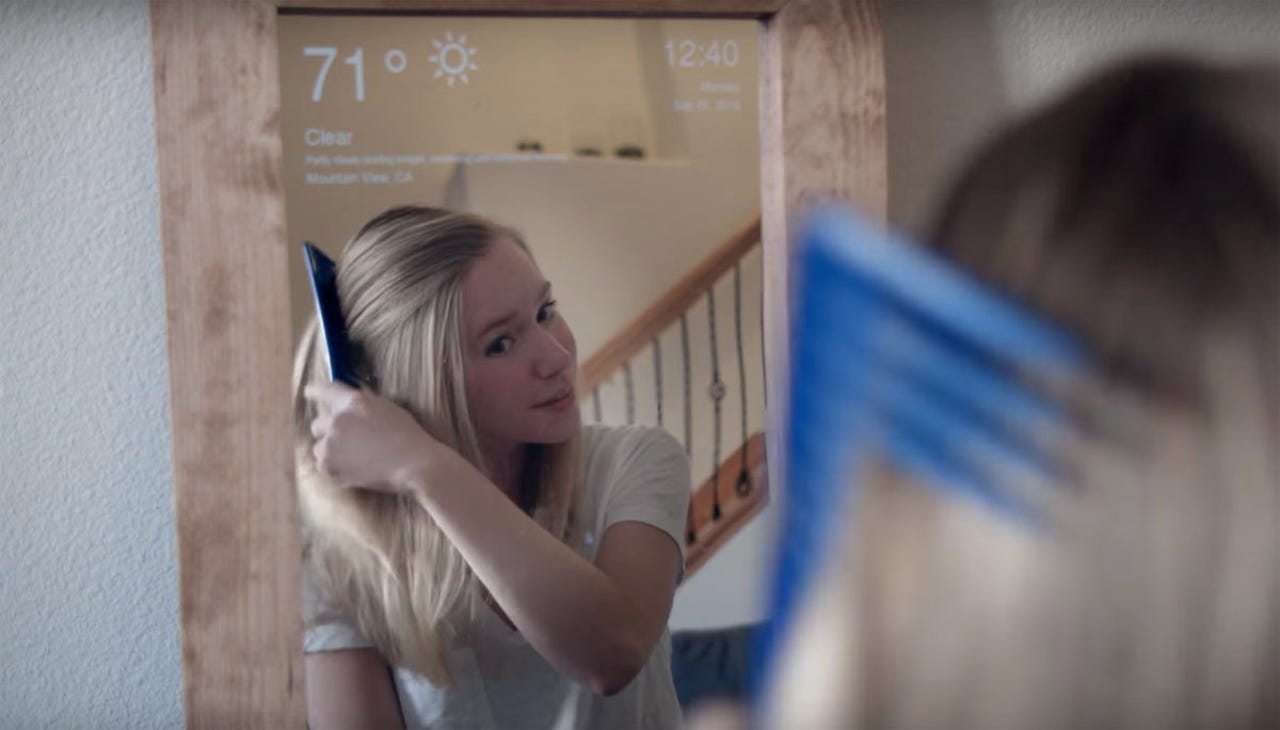21 of our favorite Raspberry Pi projects

The perfect high-tech craft project
We're big fans of the Raspberry Pi here at ZDNet. These inexpensive mini computers are amazing -- you can turn them into retro gaming consoles, printer, media servers, smart speakers, and more.
Making your own electronics from scratch may seem daunting at first, but we promise: There are plenty of simple, easy, and inexpensive Raspberry Pi projects that don't require you to code. They're great for tinkerers and makers of all ages.
Here are our favorite projects.
(Not sure what board to use? You can check out our favorite Raspberry Pi boards here.)
Hack your own R2D2
The Raspberry Pi is known for making toys way better. Case in point: The good people at Adafruit have hacked a 15-inch Hasbro Interactive R2D2 toy with a Raspberry Pi to give him remote Wi-Fi controls, a webcam, and video projection capabilities.
You can view this DIY project at the Adafruit website.
Homemade smartphone
The PiPhone is not elegant or cost-effective. It has a limited feature set, and you'll likely get detained for hours by Homeland Security if you try to take it on a plane. That said, building your own working touchscreen smartphone from scratch is undeniably cool.
Software engineer David Hunt has the step-by-step instructions and links to the code you'll need at his website.
Automated bartender
This automated bartender, designed by the folks at Hacker House, is equipped with flowmeters so it can expertly mix your favorite drinks in their exact proportions. It's a complicated project (especially if you want the same kind of professional look), but it's guaranteed to impress.
You can view the full build process at Hacker House and at the Hacker House YouTube page.
Build your own retro gaming system
One of the coolest -- and simplest -- things you can build with a Raspberry Pi board is this RetroPie emulator. It's like having your own NES Classic Edition... that also plays games from the Super Nintendo, Sega Master System, Sega Genesis, and more. (We built ours with a Raspberry Pi 3 board that supports Bluetooth, so it works with our wireless PlayStation 3 and 8bitdo NES30 controllers.)
You can download the emulation software you'll need from the RetroPie website. You'll find the build instructions there, too. The whole project takes less than 30 minutes.
...or take the game to go!
Want an even smaller gaming system? We're absolutely in love with this great RetroPi Adafruit project from the Ruiz Brothers, built with a $5 Raspberry Pi Zero board.
This isn't a starter project; there are lots of small components that need to come together. You'll need some soldering know-how and access to a 3D printer, too. But the end result -- a micro-handheld that supports your favorite classic games -- is spectacularly fun.
All the instructions and links you'll need are available at the Adafruit website.

Smart Mirror
Have an old computer monitor that you're not using? Why not turn it into your own high-tech magic mirror?
Perfecting this one will take some time: The folks at Hacker House built their own wood frame to hold the see-through mirror glass and hide the Raspberry Pi board. But the end result is fantastic -- a customizable smart mirror that displays time, temperature, and news headlines.
Palmtop Computer
Forget big, bulky laptops -- with a Raspberry Pi board, 3.5-inch display, Powerboost 1000C battery pack, wireless Rii keyboard, and a 3D printer, you can build your own palmtop computer. It's not a high-performance machine, but it's a fun tool for casual web browsing, streaming music, and other light-weight tasks.
You can learn more about this project at the Adafruit website and on its YouTube channel.
Amazon Echo clone
The voice-activated Amazon Echo smart speaker is a great tool for controlling your smart home, getting news and weather updates, streaming music, making to-do lists, and more. And with a Raspberry Pi board, you can build your own. (Yes, really!)
Building your own Echo requires a bit of work, but the finished project is worth it. Check out this YouTube video by ExplainingComputers for the step-by-step details.
Create your own 'Google Home'
Don't like the Amazon Echo ecosystem? No problem -- you can just as easily create a Google Home-based smart speaker. The folks at MagPi magazine offered a great cardboard kit to do just that in their May 2017 issue (#57) -- you just need to add your own Raspberry Pi board.
...or just stuff Alexa inside Teddy Ruxpin.
If you want to get real weird with your homemade Alexa project, do what YouTube's Tinkernut did: Stuff one into a 30-year-old Teddy Ruxpin doll.
This project requires a bit more work: You'll need an Arduino microcontroller to convert Alexa's analog audio signal to a digital one so the animatronics stay in sync, and there's some soldering to do. For the full project information, can check out the project on Tinkernut's website and view the finished product on YouTube.
The world's smallest arcade cabinet
This amazing miniature is packed with electronics: There's a Raspberry Pi Zero, 0.96-inch OLED, and an audio amplifier built in. It runs a version of the RetroPie emulator to display the hottest arcade games of yesteryear in 96 x 64 RGB glory. And, yes, it actually works.
You can check out this arcade micro-machine in action over on Adafruit's YouTube. There's no step-by-step how-to guide for this one, but you can read a detailed breakdown of the project at the Adafruit website.
3G-controlled RC car
This isn't the simplest project, but it may be one of the most impressive: Maker Alin Iordache upgraded a standard RC car into a smartphone-driven 3G car using a Raspberry Pi B+.
Some soldering is required for this one, but thankfully, Iordache's blog post walks you through the process. You can see the completed product in action on YouTube.
Internet photo frame
It's easy to build your own digital picture frame using a spare computer monitor: All you need is a Raspberry Pi board and a nice frame.
This particular Instructables project uses a hardwired ethernet connection to retrieve photos from Flickr, but it works just as well with a Wi-Fi enabled Raspberry Pi board. Check the project out on YouTube.
Pixel art frame
If you want a truly unique picture frame, though, we love Frederick Vandenbosch's rad pixel art frame -- it's a blast from our collective 8-bit past. This project uses a Raspberry Pi Zero, a 32x32 RGB LED matrix, and a couple other small parts to display your choice of images, social media notifications, weather forecasts, and more.
For more on this project, check out Frederick Vandenbosch's website and his YouTube page.
Build your own media center
You can turn your Raspberry Pi into a home media server with Open Source Media Center (OSMC). Based on the Kodi project, OSMC lets you stream the most popular media formats from just about anywhere. There's even an app store that connects you to YouTube, SoundCloud, Twitch, and TuneIn.
You can download the software you'll need at the OSMC website.
Wi-Fi Touchscreen Digital Camera
The Raspberry Pi's camera add-on can be used to make this simple 5MP point-and-shoot digital camera that automatically transfers photos via Wi-Fi. The camera offers effects (like the Watercolor mode shown), adjustable ISO settings, and even night vision, provided you use an infrared-sensitive camera board.
You can view the finished product on Adafruit's YouTube page. The instructions and code are on the company's website.
Reprogram an Amazon Dash button
Amazon's $5 Dash Buttons let you to place orders for products such as Tide with a simple press. But you can easily reprogram this button with Raspberry Pi to do just about anything, allowing you to create your own smart doorbell, IFTTT trigger, or thousands of other mini projects.
You can check out the details of this particular project at the Raspberry Pi website.
Make a dumb printer "smart"
Have an old, non-networked USB printer laying around? Give it an upgrade with a Raspberry Pi print server and start printing wirelessly! It's a relatively simple project: All you need is a Wi-Fi-enabled Raspberry Pi, a MicroSD card, and this walkthrough on PiMyLifeUp.
3D Printed Pipboy
Attention Fallout fans, cosplayers, and lovers of absurdly large wristwear: You can build your own working Pipboy 3000 using Raspberry Pi, a 3.5-inch screen, a 3D printer (or printing service), and a few other assorted parts. The finished product displays monochrome maps (via OpenStreetMap) and plays sounds from the game.
The step-by-step walkthrough on how to build it is on the Adafruit website.
Motion-detecting alarm
A great project for a kid's room, Jeff Highsmith's PiLarm is a motion-detecting alarm built from a Raspberry Pi. When an intruder is detected by the passive infrared sensor, the device will give you a few moments to enter a disarm PIN before an audio alarm and warning light go off. A picture is then taken of the intruder and emailed to you.
You can see it in action at the Make YouTube page.
PiDesk
The PiDesk, created by Frederick Vandenbosch, is a futuristic take on the traditional workspace powered by a Raspberry Pi B+ board. The lower right corner of its surface features hidden capacitive touch controls, which turn the computer on and raise the monitor up out of the desk.
The project is very complicated, but Vandenbosch works you through it step-by-step on his Element 14 blog. You can see the desk in action on YouTube.